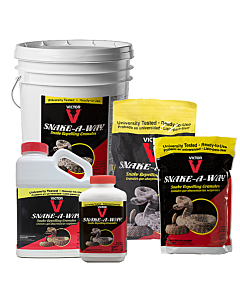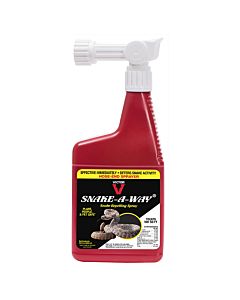
When most people see a snake slithering towards them, they are instantly instilled with a sense of fear. Getting bitten by snakes is an international phobia that permeates cultures across the globe. Studies have shown that people are more afraid of snakes than public speaking, heights, needles, and even spiders. While getting bitten by a snake is rare, it does happen and cements a person’s worst fears.
Panicking after a snake bite can be just as dangerous as the bite itself. That’s why we’ve compiled this comprehensive guide of dos and don'ts if you have the unfortunate experience of getting bitten by these slithering reptiles. Below you’ll find signs and symptoms of snake bites, first aid best practices, and snakebite prevention tips to keep you and your family safe this summer.
Understanding Snake Bites
After reading about different snakes, you might be starting to feel like you never want to venture outdoors again for fear of being bitten. However, your chances of getting bitten by a snake in the United States are next to zero. Exact numbers are not known, but it is estimated that 5.4 million snake bites occur each year worldwide with 2.7 million being from venomous snakes. The vast majority of these bites occur in Africa, Asia, and Latin America. Between 81,000-138,000 people die each year from snake bites, but this is largely due to a lack of efficient health care.
To put it in perspective, you are three times more likely to be killed by a dog than a snake. Nearly nine times as likely to be fatally stung by a bee or struck by lightning. Fewer than 37,500 people are bitten by venomous snakes in the United States each year and only one in 50 million people will die from a snake bite. So, while snakes may slither through your nightmares, you probably have nothing to worry about if you take the proper precautions.
Most people are unaware that snakes choose whether or not to inject venom into their bite victims. Dry bites are a snake bite from a venomous snake that does not deliver any venom. According to studies conducted by the University of Florida, 20-25% of venomous snake bites are dry bites with the exception of the coral snake which delivers dry bites 50% of the time.
Signs & Symptoms of Snake Bites
Now that we know more about snakes and venom, it’s time to learn the crucial signs and symptoms people exhibit when bitten by a snake. While you’ll most likely feel a bite, you may not always see what has bitten you or another person. Identifying these symptoms could save a person’s life, so be sure to remain aware of the telltale signs. Symptoms may vary depending on the species of snake, but most symptoms remain the same and include one or several of the following.
- A pair of puncture marks at the wound
- Redness and/or swelling around the bite
- Pain at the site of the bite
- Nausea or vomiting
- Difficulty breathing
- Impaired vision
- Increases sweating or salivation
- Numbness or tingling in the face or limbs
- Weakness
Snake Bite First Aid

There are many misconceptions about what to do after being bitten by a snake. To clear that up, follow these steps to minimize risk and stabilize the person who has been bitten.
- Call an Ambulance or Emergency Services -- The first thing you should do in any emergency is call 911. Even if you think the snake wasn’t venomous, it’s always best to be cautious. Alert emergency services that you are dealing with a snake bite to ensure proper help is on the way.
- Recall and Record Details -- Do not approach a snake or chase after it. If you can remember any details write them down or record them in any device you may have on you. This can help medical professionals treat their patient(s) more effectively. If you perform any first aid, you may be asked by emergency services exactly what you did, so try to record your actions as well.
- Remain Calm and Still -- Venom is typically carried in the lymphatic system of a person’s body which circulates throughout the entire body whenever it moves. Moving around can actually cause the venom to circulate faster and make the situation more dangerous. Make sure you aren’t in any danger from the snake and have the victim lay down flat and try to keep them calm.
- Apply Pressure and Cover the Bite -- Most snake bites occur on the arms, hands, feet, or legs. Apply a pressure immobilization bandage to stop the spread of the venom. This also protects the venom which can be tested at a medical facility to find the best antivenom possible. Simply roll a bandage over the bite and wind it tightly around the limb. Mark the spot of the bite on the bandage with whatever is available and keep the limb as still as possible.
Avoid These Common Mistakes
More than almost any other situation that requires first aid, snake bites are almost always mistreated. Whether it’s due to myths or what you’ve seen in movies, snake bites only require a few basic steps before medical professionals take over. If in doubt, avoid the following common mistakes at all costs.
- Do NOT Apply a Tourniquet -- Applying a tourniquet restricts blood flow which can cause supplemental problems and restricts the venom from spreading. The more venom is trapped in one spot, the more damage it will do. Allowing it to spread slowly will dilute the venom and make it less harmful.
- Do NOT Apply Ice -- Applying ice to a wound may restrict blood flow which can cause complications in the area and will not help prevent the venom from causing damage.
- Do NOT Cut the Wound -- Cutting into the skin will cause tissue damage and increase the chances of infection and does not provide any medical benefit against the venom.
- Do NOT Suck Out the Venom -- By ingesting venom, you are putting yourself at risk and it will not positively impact the snakebite victim. In fact, you may increase their risk of infection by transferring bacteria directly into the wound.
- Do NOT Consume Caffeine or Alcohol -- Caffeine and alcohol can speed up a person’s circulatory system and can act as a depressant when its effects wear off, lowering their ability to fight infection.
- Do NOT Try to Capture the Snake -- Attempting to capture or chase a snake to identify which species delivered the bite is dangerous and may result in more snake bites. Try to remember the features of the snake, but never go searching for it.
How to Prevent Snake Bites

Most snakes do not pose much of a threat to humans, but when they feel threatened they may bite. Whether you’re out exploring or relaxing in your yard, there are plenty of ways you can prevent snake bites. The more ways you prepare yourself and your home, the less likely you will be to encounter a snake, reducing your chances of getting bitten immensely.
- Remain Aware of Your Surroundings -- Snakes blend in well with their surroundings. Whether you’re out for a walk or going on a hike, always be aware that a snake could be nearby. Keep an eye out for any snake habitats or signs of snakes so you can avoid them effectively.
- Know Your Snake Habitats -- Most snakes will run and hide when humans approach. They may slither into holes in the ground, hide under logs, or climb trees. Before you step on a log or grab a branch, consider the possibility that a snake may be hiding from you in those places.
- Keep Your Distance -- The best way to prevent a snake bite is to avoid coming into contact with them altogether. Never chase, follow, or try to pick up a snake. Even if you’re sure it isn’t venomous, a snake can and will bite you if it thinks it’s necessary.
- Remove Attractants From Your Property -- Snakes most commonly take up residence on your property due to an abundance of prey. Keep your home rodent-free by using traps and repellents so snakes don’t see your property as the perfect spot to hunt for food.
- Eliminate Potential Snake Shelter -- Snakes may also use your property for shelter, especially if there are damp, cool, dark areas where they can hide. Piles of firewood, piles of debris or junk, mulch or garden beds, shrubbery growing against foundations, and even unmowed lawns can provide adequate shelter for snakes. Keep your gardens and lawns well maintained and clean up any areas that snakes could use around your property.
- Use Snake Repellents -- Snakes largely use their strong sense of smell to navigate and find prey. Effective snake repellents take advantage of this by utilizing strong scents proven to send snakes slithering away. Use a combination of liquid and granular repellents to ensure you have complete coverage around your home and property.
How Have You Prevented Encounters with Snakes?
Share your stories with us and ask any questions you may have on our Facebook page. We have tons of great articles and tips in our Learning Center to help you learn more, stay protected, and keep snakes away from your home. Signing up for our e-newsletter is another great way to stay connected. It features exclusive sales, new products, and so much more!





